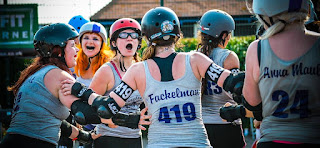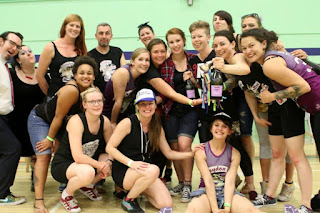In the week that letters are no longer allowed as part of a player's number, I thought I'd re-visit the subject of derby names. It's something that I know has been talked about over and over, but the majority of the forum posts and brief articles in the derby press I found in my quick research session seemed to be from a few years ago, when the derby scene was arguably quite different to how it is now.
One of the posts I stumbled upon was this 2007 beauty from Cherry Rockette on "how to choose a derby name". The "number" section in that post makes me twitch as a skater, I can't imagine quite how horrible it would make officials feel! I think, perhaps a more appropriate question in derby at the moment is "whether to choose a derby name". Unsurprisingly, I can't answer that with a simple yes or no, but I'll put forward a few topics that are doing the rounds at the moment about how derby names fit into the current incarnation of roller derby, and how this might affect new skaters just starting out.
When I started skating in 2012, we were told fairly early on in our rookie program that we had to earn our derby name. It was something of a reward to be allowed to get scrim tops printed with your chosen name once you had mastered your minimum skills and been cleared for scrimmage. We were also referred to the two evils master data sheet, to make sure our names weren't already registered by someone else anywhere in the world. Yup, that was a thing. Fast forward a couple of years to the 2014 world cup in Dallas, and you would have noticed that some of the best known derby skaters in the world were appearing for the first time under their legal name to represent their country. Some skaters are choosing to stick with their given name from the start, and associate their accomplishments with their legal identity rather than an alias. Increasingly, more and more league members, from brand new to veteran, are choosing to forego the alter ego of a skate name and wear their surnames on their backs instead.
 |
| [John Hesse] |
Arguably, the main reason to do away with pre-established nicknames in this sport is to appear more professional. We're in a position now where the recent champs finals were shown on ESPN in the US, and more and more coverage is being given to roller derby across Europe and beyond. But are derby names necessarily unprofessional? Well, that probably depends on what your derby name is.
Recently, some skaters' names were censored by ESPN during the champs coverage from Minnesota. This has unsurprisingly sparked off some discussion about whether it is necessary to censor names, and if so, how is the censorship decided. Ultimately, one should probably assume that names which are deemed to be offensive are unlikely to be broadcast on mainstream media. But the question arises then of what is considered offensive. There's a difference between obscene, indecent and profane, as described in the Federal Communications Commision. Going by these legal stipulations, one would assume that obscene names would never be broadcast, and indecent or profane names might be suitable for televised display only between the hours of 10pm and 6am, which isn't generally when games are scheduled. It's not hard to see how many derby names might face censorship under one of the 3 measures used to decide if material is indecent: "whether the material appears to pander or is used to titillate or shock".
So the situation seems to be that if your derby name could possibly be construed as indecent or profane, then it doesn't have a place in mainstream media, at least in the USA. But is that right? The majority of forum posts about the censorship of names are from a few years ago, although the sentiment seems to remain the same. I broke my self imposed internet rule of never reading to comments to trawl through the hundreds of responses to this post from Ginger Snaps back in 2011. There are lots of interesting points interspersed with expected amounts of mud flinging and trolling. The recurring theme seems to be that if you and your team are hell bent on presenting a totally commercial, vanilla, conventionally athletic image, then legal names are the way forward. If you sit at the opposite end of the spectrum and thrive on being part of an alternative subculture that prides itself on being provocative, X-rated and anarchic, then by all means, choose the most obscene derby name you can conjure up.
The trouble is, most leagues and their members fall somewhere in between these two rather extreme examples of the roller derby ethos. Most skate names are not considered obscene, indecent or profane, however, which brings us back to the question of whether there's any problem with choosing to skate under a pseudonym. People in the "legal names are more professional" camp would argue that other professional athletes don't have nicknames, and that to be considered a "serious" sport, roller derby should look to mirror this. Some commenters on the aforementioned derbylife thread have mentioned that those sportspeople who do have nicknames have earnt them over time, rather than choosing a name themselves from the off. And obviously not using derby names at all removes the question of censorship in broadcast media.
I should mention that I'm a supporter of derby names for those who want to use them, and as such I probably present a more heartfelt argument for reasons to keep them as an option, rather than to drop them altogether. This is probably a result, for the most part, of living with a surname that very few people can pronounce. The thought of hearing announcers trip over my family name as I'm lining up to play gives me a nervous twitch. I also like the fact that derby names allow some people to embrace an alter ego that they would otherwise not have the confidence to present. This probably applies more to newer skaters and leagues outside of D1 where a high level of athletic confidence is perhaps less commonplace. Additionally, whilst I love the fact that roller derby is getting more news coverage and becoming more accessible, I'm not sure it needs to be homogenised to the extent that it has no aspects left of the alternative culture from which it grew. It's understandable to see players ditching the clichéd fishnets and skirts for sleeker sportswear, that's something that has a physical impact to gameplay. However, I'm not convinced that it's entirely necessary to remove all the "fun" aspects of this sport, just to fit in with convention. I could also argue that there are other professional disciplines who use pseudonyms - authors and journalists often publish under different names, and actors sometimes have to change their names for equity membership. Granted, derby names usually don't usually resemble legal names quite so much, but for me, the principle is the same. There are derby players who have personal training businesses built around their derby names - does this make them less professional? Not in my opinion. In those cases, the name is a brand, it's a professional sports persona, it has more impact than a legal name on its own.
Granted, this doesn't fully answer the question of censorship in broadcast media. It could be argued that the classification mentioned above is too extreme, and that we shouldn't be censoring free speech for fear of offending all and sundry. But for me, that's a totally different discussion. One that's far broader than the world of roller derby nicknames.
What are your thoughts on derby names? Have you dropped your skate name to skate under your legal name? Did you choose not to have one in the first place? I'd love to hear your thoughts.


















































